torch
包 torch 包含了多维张量的数据结构以及基于其上的多种数学操作。另外,它也提供了多种工
具,其中一些可以更有效地对张量和任意类型进行序列化。
它有 CUDA 的对应实现,可以在 NVIDIA GPU 上进行张量运算(计算能力>=2.0)。
torch.is_tensor[source]
torch.is_tensor(obj)
如果 obj 是一个 pytorch 张量,则返回 True
参数: obj (Object) – 判断对象
torch.is_storage [source]
torch.is_storage(obj)
如何 obj 是一个 pytorch storage 对象,则返回 True
参数: input (Object) – 判断对象
torch.__set_default_tensor_type__[source]
torch.set_default_tensor_type(t)
torch.numel
torch.numel(input)->int
返回 input 张量中的元素个数
参数: input (Tensor) – 输入张量
例子:
>>> a = torch.randn(1,2,3,4,5)
>>> torch.numel(a)
120
>>> a = torch.zeros(4,4)
>>> torch.numel(a)
�
16
torch.set_printoptions[source]
torch.set_printoptions(precision=None, threshold=None, edgeitems=None,
linewidth=None, profile=None)
设置打印选项。 完全参考自 Numpy。
参数:
precision – 浮点数输出的精度位数 (默认为 8 )
threshold – 阈值,触发汇总显示而不是完全显示(repr)的数组元素的总数 (默认为 1000)
edgeitems – 汇总显示中,每维(轴)两端显示的项数(默认值为 3)
linewidth – 用于插入行间隔的每行字符数(默认为 80)。Thresholded matricies will ignore
this parameter.
profile – pretty 打印的完全默认值。 可以覆盖上述所有选项 (默认为 short, full)
创建操作 Creation Ops
torch.eye
torch.eye(n, m=None, out=None)
返回一个 2 维张量,对角线位置全 1,其它位置全 0
参数:
n (int ) – 行数
m (int, optional) – 列数.如果为 None,则默认为 n
out (Tensor, optinal) - Output tensor
返回值: 对角线位置全 1,其它位置全 0 的 2 维张量
返回值类型: Tensor
例子:
>>> torch.eye(3)
1 0 0
0 1 0
0 0 1
[torch.FloatTensor of size 3x3]
�
from_numpy
torch.from_numpy(ndarray) → Tensor
Numpy 桥,将 numpy.ndarray 转换为 pytorch 的 Tensor。 返回的张量 tensor 和 numpy 的
ndarray 共享同一内存空间。修改一个会导致另外一个也被修改。返回的张量不能改变大小。
例子:
>>> a = numpy.array([1, 2, 3])
>>> t = torch.from_numpy(a)
>>> t
torch.LongTensor([1, 2, 3])
>>> t[0] = -1
>>> a
array([-1, 2, 3])
torch.linspace
torch.linspace(start, end, steps=100, out=None) → Tensor
返回一个 1 维张量,包含在区间 start 和 end 上均匀间隔的 step s 个点。 输出 1 维张量的长
度为 steps。
参数:
start (float) – 序列的起始点
end (float) – 序列的最终值
steps (int) – 在 start 和 end 间生成的样本数
out (Tensor, optional) – 结果张量
例子:
>>> torch.linspace(3, 10, steps=5)
3.0000
4.7500
6.5000
8.2500
10.0000
[torch.FloatTensor of size 5]
>>> torch.linspace(-10, 10, steps=5)
-10
-5
0
�
5
10
[torch.FloatTensor of size 5]
>>> torch.linspace(start=-10, end=10, steps=5)
-10
-5
0
5
10
[torch.FloatTensor of size 5]
torch.logspace
torch.logspace(start, end, steps=100, out=None) → Tensor
返回一个 1 维张量,包含在区间 10start10start 和 10end10end 上以对数刻度均匀间隔的 steps
个点。 输出 1 维张量的长度为 steps。
参数:
start (float) – 序列的起始点
end (float) – 序列的最终值
steps (int) – 在 start 和 end 间生成的样本数
out (Tensor, optional) – 结果张量
例子:
>>> torch.logspace(start=-10, end=10, steps=5)
1.0000e-10
1.0000e-05
1.0000e+00
1.0000e+05
1.0000e+10
[torch.FloatTensor of size 5]
>>> torch.logspace(start=0.1, end=1.0, steps=5)
1.2589
2.1135
3.5481
5.9566
�
10.0000
[torch.FloatTensor of size 5]
torch.ones
torch.ones(*sizes, out=None) → Tensor
返回一个全为 1 的张量,形状由可变参数 sizes 定义。
参数:
sizes (int...) – 整数序列,定义了输出形状
out (Tensor, optional) – 结果张量 例子:
>>> torch.ones(2, 3)
1 1 1
1 1 1
[torch.FloatTensor of size 2x3]
>>> torch.ones(5)
1
1
1
1
1
[torch.FloatTensor of size 5]
torch.rand
torch.rand(*sizes, out=None) → Tensor
返回一个张量,包含了从区间[0,1)的均匀分布中抽取的一组随机数,形状由可变参数 sizes 定
义。
参数:
sizes (int...) – 整数序列,定义了输出形状
out (Tensor, optinal) - 结果张量 例子:
>>> torch.rand(4)
0.9193
0.3347
0.3232
0.7715
[torch.FloatTensor of size 4]
�
>>> torch.rand(2, 3)
0.5010 0.5140 0.0719
0.1435 0.5636 0.0538
[torch.FloatTensor of size 2x3]
torch.randn
torch.randn(*sizes, out=None) → Tensor
返回一个张量,包含了从标准正态分布(均值为 0,方差为 1,即高斯白噪声)中抽取一组随机数,
形状由可变参数 sizes 定义。 参数:
sizes (int...) – 整数序列,定义了输出形状
out (Tensor, optinal) - 结果张量
例子::
>>> torch.randn(4)
-0.1145
0.0094
-1.1717
0.9846
[torch.FloatTensor of size 4]
>>> torch.randn(2, 3)
1.4339 0.3351 -1.0999
1.5458 -0.9643 -0.3558
[torch.FloatTensor of size 2x3]
torch.randperm
torch.randperm(n, out=None) → LongTensor
给定参数 n,返回一个从 0 到 n -1 的随机整数排列。
参数:
n (int) – 上边界(不包含)
例子:
>>> torch.randperm(4)
�
2
1
3
0
[torch.LongTensor of size 4]
torch.arange
torch.arange(start, end, step=1, out=None) → Tensor
返回一个 1 维张量,长度为 floor((end−start)/step)floor((end−start)/step)。包含从 start 到
end,以 step 为步长的一组序列值(默认步长为 1)。
参数:
start (float) – 序列的起始点
end (float) – 序列的终止点
step (float) – 相邻点的间隔大小
out (Tensor, optional) – 结果张量
例子:
>>> torch.arange(1, 4)
1
2
3
[torch.FloatTensor of size 3]
>>> torch.arange(1, 2.5, 0.5)
1.0000
1.5000
2.0000
[torch.FloatTensor of size 3]
torch.range
torch.range(start, end, step=1, out=None) → Tensor
�
返回一个 1 维张量,有 floor((end−start)/step)+1floor((end−start)/step)+1 个元素。包含在半
开区间[start, end)从 start 开始,以 step 为步长的一组值。 step 是两个值之间的间隔,
即 xi+1=xi+stepxi+1=xi+step
警告:建议使用函数 torch.arange()
参数:
start (float) – 序列的起始点
end (float) – 序列的最终值
step (int) – 相邻点的间隔大小
out (Tensor, optional) – 结果张量
例子:
>>> torch.range(1, 4)
1
2
3
4
[torch.FloatTensor of size 4]
>>> torch.range(1, 4, 0.5)
1.0000
1.5000
2.0000
2.5000
3.0000
3.5000
4.0000
[torch.FloatTensor of size 7]
torch.zeros
torch.zeros(*sizes, out=None) → Tensor
返回一个全为标量 0 的张量,形状由可变参数 sizes 定义。
参数:
sizes (int...) – 整数序列,定义了输出形状
out (Tensor, optional) – 结果张量
�
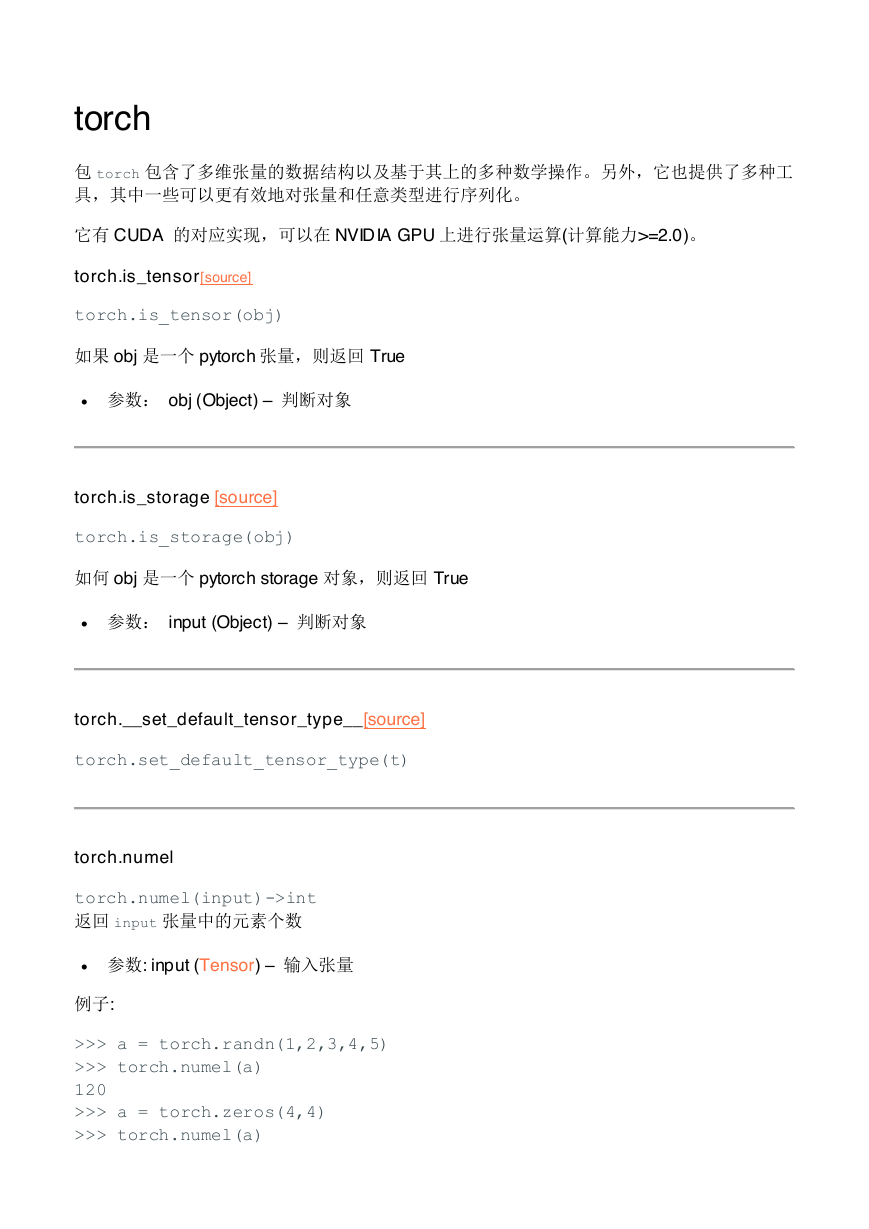
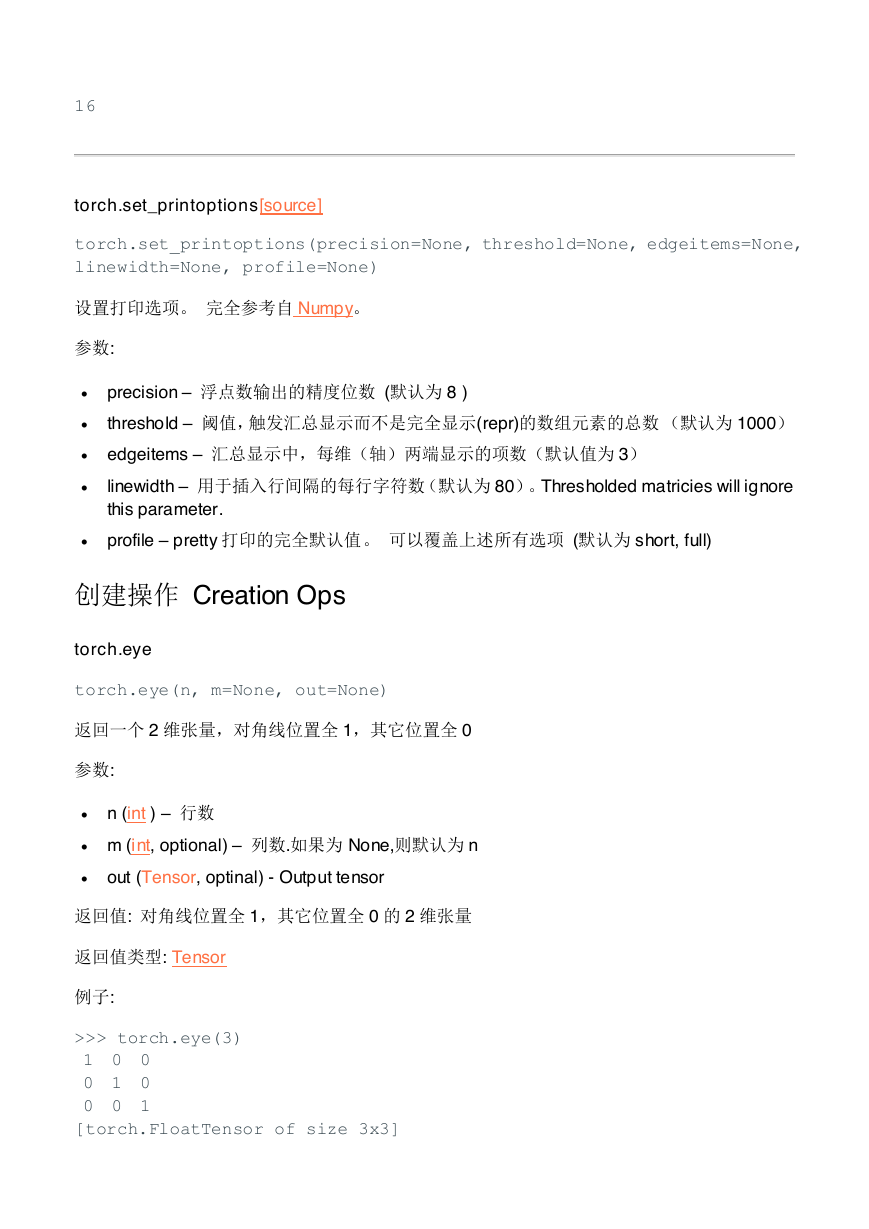
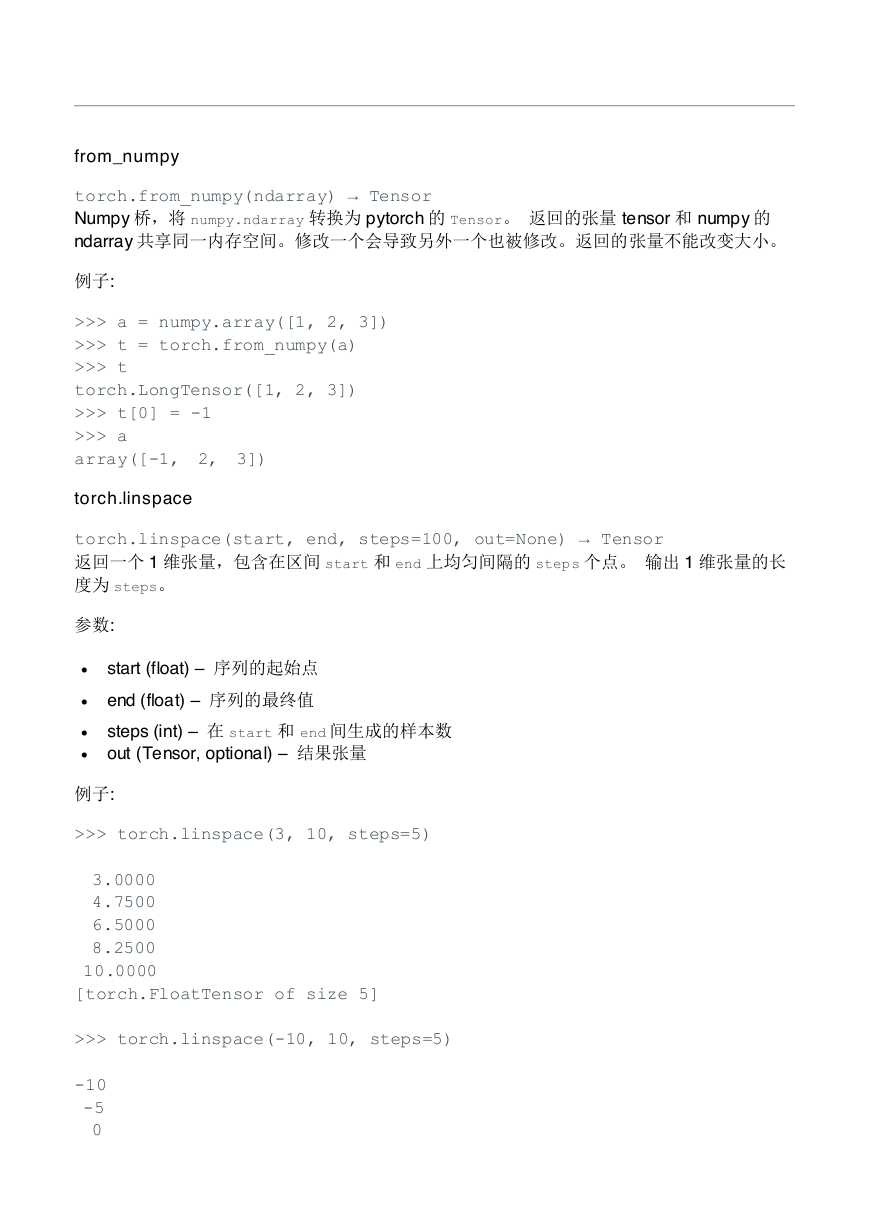

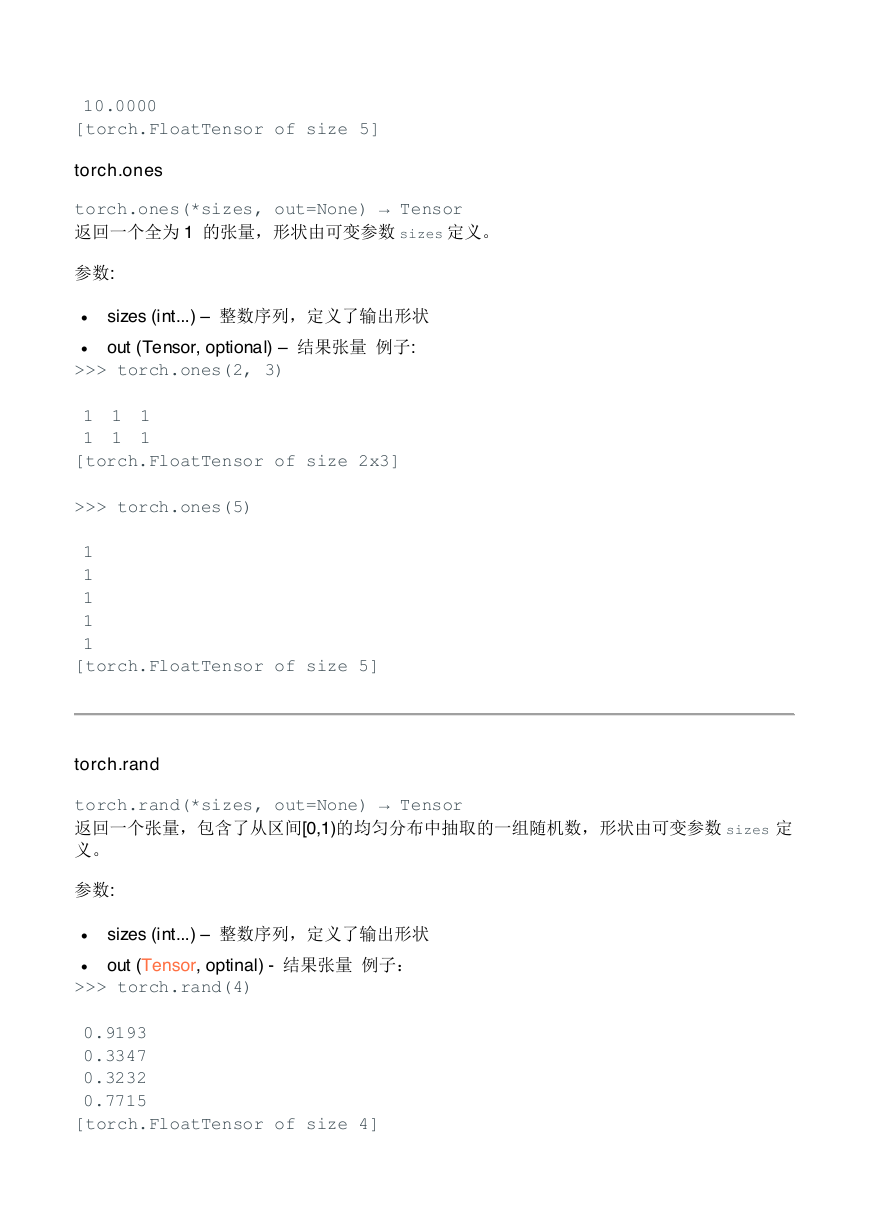
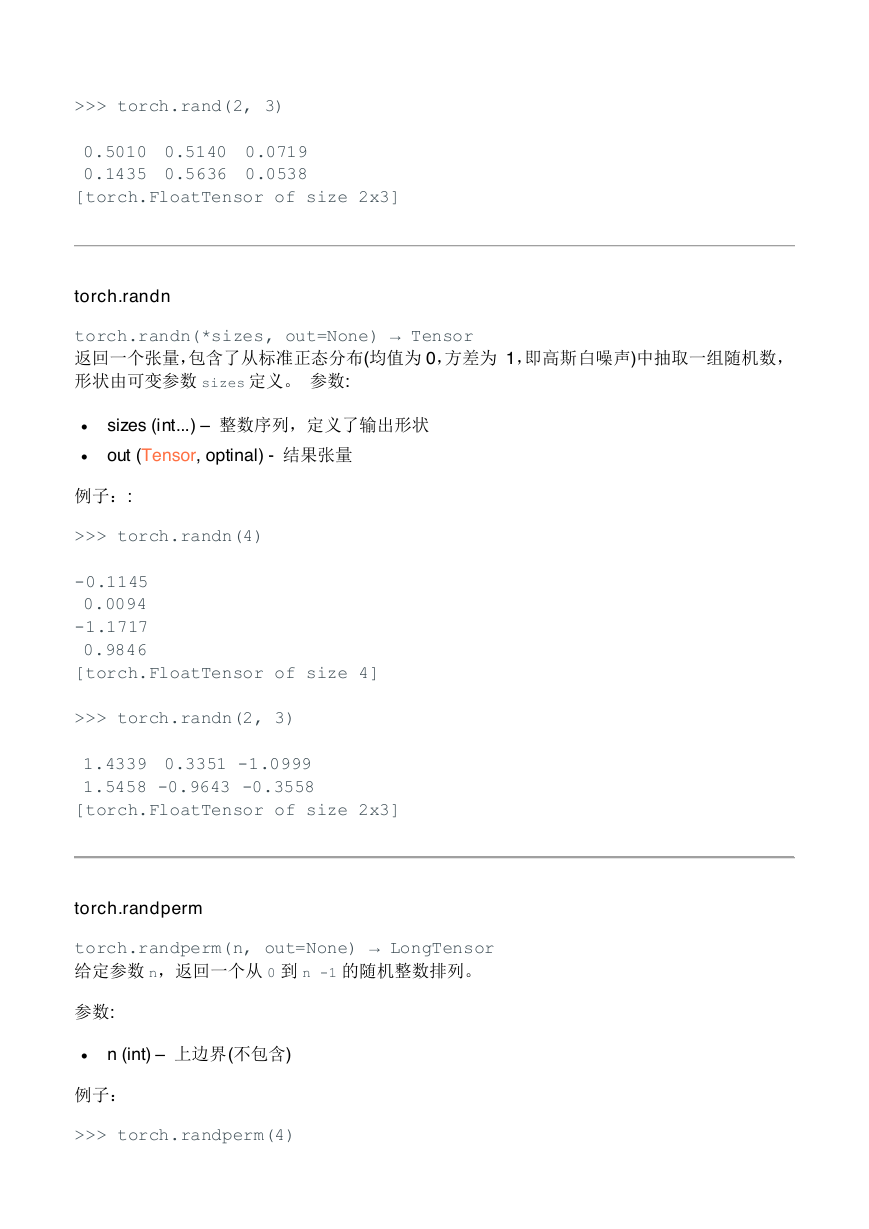










 2023年江西萍乡中考道德与法治真题及答案.doc
2023年江西萍乡中考道德与法治真题及答案.doc 2012年重庆南川中考生物真题及答案.doc
2012年重庆南川中考生物真题及答案.doc 2013年江西师范大学地理学综合及文艺理论基础考研真题.doc
2013年江西师范大学地理学综合及文艺理论基础考研真题.doc 2020年四川甘孜小升初语文真题及答案I卷.doc
2020年四川甘孜小升初语文真题及答案I卷.doc 2020年注册岩土工程师专业基础考试真题及答案.doc
2020年注册岩土工程师专业基础考试真题及答案.doc 2023-2024学年福建省厦门市九年级上学期数学月考试题及答案.doc
2023-2024学年福建省厦门市九年级上学期数学月考试题及答案.doc 2021-2022学年辽宁省沈阳市大东区九年级上学期语文期末试题及答案.doc
2021-2022学年辽宁省沈阳市大东区九年级上学期语文期末试题及答案.doc 2022-2023学年北京东城区初三第一学期物理期末试卷及答案.doc
2022-2023学年北京东城区初三第一学期物理期末试卷及答案.doc 2018上半年江西教师资格初中地理学科知识与教学能力真题及答案.doc
2018上半年江西教师资格初中地理学科知识与教学能力真题及答案.doc 2012年河北国家公务员申论考试真题及答案-省级.doc
2012年河北国家公务员申论考试真题及答案-省级.doc 2020-2021学年江苏省扬州市江都区邵樊片九年级上学期数学第一次质量检测试题及答案.doc
2020-2021学年江苏省扬州市江都区邵樊片九年级上学期数学第一次质量检测试题及答案.doc 2022下半年黑龙江教师资格证中学综合素质真题及答案.doc
2022下半年黑龙江教师资格证中学综合素质真题及答案.doc